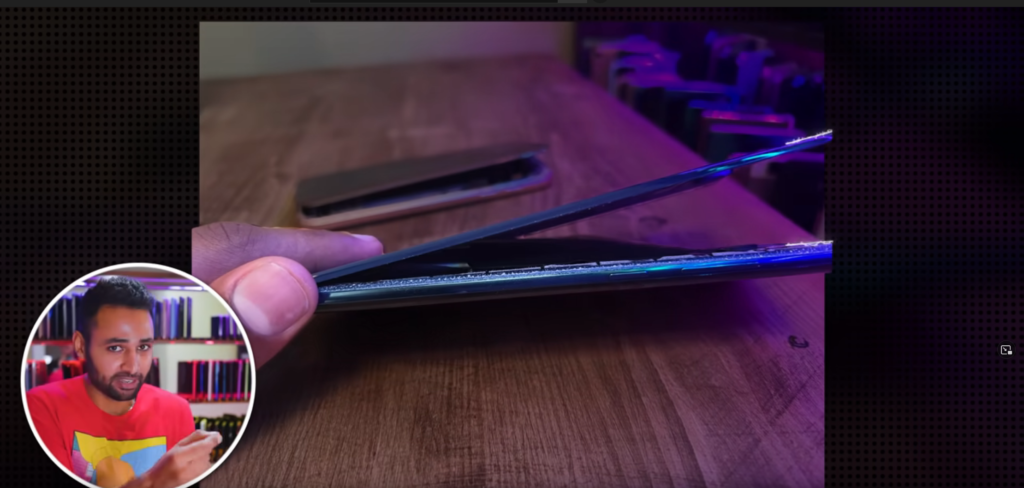It’s not every day that problems literally come to haunt a company. In 2016, Samsung had the biggest tech scandal in the past decade with its most popular device – the Galaxy Note 7 – becoming an explosive hit. Now it looks like the problem is back to haunt them in newer devices.
Tech YouTuber, Arun Rupesh Maini – better known as Mr WhoseTheBoss – has recently released a video highlighting a confounding problem that he faced almost exclusively with his Samsung devices. The issue came to light when he realised that his Galaxy Note 8 had its back detached due to the battery expanding. Keep in mind, that the same issue was at the centre of Samsung’s Galaxy Note 7 fiasco back in 2016. While it would seem like the issue was occurring exclusively on Note devices, he also noted that the same thing happened on his Galaxy S6 and Galaxy S10. It’s worth noting also that the phones were not actively being used but were powered down for storage.
Thinking it was a remote issue and possibly caused by the recent heatwave in the UK, he proceeded to turn to the internet. The issue, however, seemed to be a well-known fact swept under the rug. In fact, Samsung themselves reached out to Mrwhosetheboss requesting that the phones be passed back to Samsung for further investigation. It’s been about 2 months since and there hasn’t been any word from the manufacturer.
More interestingly, it began to surface that other tech reviewers were facing the same issue. Matt Ansini from This Is shared a similar tweet noting that every Samsung phone that was more than three years old in storage had experienced the same issue. Upon further investigation, Mrwhosetheboss noticed that the same had happened to a number of Samsung devices in his storage including the Galaxy Z Fold 2 was on the verge of doing the same.

Another prolific Tech Youtuber – Marques Brownlee, better known as MKBHD – is also featured in the video noting the same occurrence in his own stash of devices. He mentions, “We always find like one or maybe two phones that the battery’s swollen up and have to get rid of it. And every single time it’s been a Samsung phone.” The same occurrence was noted by Zack Nelson from the popular YouTube channel JerryRigEverything. However, Zack provided an explanation noting the likely cause is the degradation of the electrolyte in the battery which releases a gaseous byproduct that is causing the bloating. Zack did further investigations to puncture the bloated batteries noting that Samsung has put in multiple measures to prevent the battery from exploding. However, he did note that it would be risky to charge the battery.
If the situation sounds familiar, it’s because Samsung’s Galaxy Note 7, had a similar issue which resulted in early units combusting in various situations. The common thread, however, was that the phones in each case were charging or had been charged very recently before the explosive event. What’s more disturbing is that after the fiasco, Samsung did take to the stage to apologise and reaffirm its commitment to end-user safety. In fact, the company highlighted multiple steps that it would be taking to ensure that the issue wouldn’t reoccur. So how are we here – again?

Having seen the video, we did a check on our own Samsung devices here at techENT. So far, we haven’t noticed any bloating in the Galaxy S7 or the Note 5 that we had in storage. The older Galaxy A7 also seems to be in good condition on the outside. It is worth noting that the Galaxy S7 was actually still being used until very recently and had a very diminished battery capacity.
That said, Arun and Zack also highlight an issue that should be more worrying to consumers. Every battery shipped, has a marking which informs consumers that they are supposed to remain inert without any chemical changes for a given amount of time. A majority of the devices that have been highlighted are marked with a 5-year guarantee. So, how are we seeing devices that are as recent as two years facing this issue?
The simple answer would be that Samsung has a major problem when it comes to manufacturing the batteries whether it is in the electrolytes themselves or any other part of the manufacturing. It’s more alarming that Samsung’s own quality controls have failed to detect the issue before these devices.
That said, we’re not chemical engineers nor are we experts in battery manufacturing. We’ll have to wait to see what Samsung says about the issue now that it’s out in the open.






